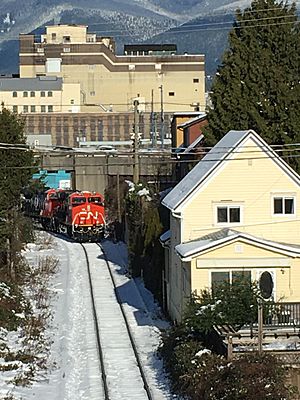Militant Mothers of Raymur facts for kids
The Militant Mothers of Raymur were a group of brave women who took action to protect their children. Starting on January 6, 1971, they blocked railway tracks near their homes. They were very worried about the safety of children. These kids had to cross busy train tracks to get to Admiral Seymour Elementary school. This school was in the Strathcona neighbourhood of Vancouver, British Columbia, Canada.
The train tracks belonged to Burlington Northern Railway. They were mostly used by Canadian National Railways to move train cars. About 400 children crossed these tracks every day to go to and from school.
The mothers had tried for months to get a safe crossing. They had signed petitions and gone to many meetings. But nothing changed. They asked the train company to stop trains when children were going to school. They were upset that their children's safety was not important. They saw kids climbing over slow-moving trains to cross. Many families lived in the Raymur Place Social Housing Project (now Stamps Place). This was a poor neighbourhood, and the mothers felt their concerns were ignored.
Contents
Taking Action for Safety
Finally, the mothers decided to take a stand. They set up a camp right on the railway tracks. This was near Pender and Raymur streets. Their action stopped all train traffic. They held signs that said "Children vs. Profit" and "Petitions Don't Work." Some of the mothers included Judith Stainsby, Carolyn Jerome, Alice Hamilton, Jean Amos, and Toni Cowlishaw. Other mothers like Ollie Strauman, Barbara Burnet, and Joan Morelli also joined. Sheila Turgeon, Muggs Sigurgeirson, Babs Cain, Dorothy Cox, and Liisa Atva (who was a teenager) were also part of the group.
Their protest worked! Local politicians and the train companies had to find a solution. Train officials promised to stop trains during school travel times. City officials also promised to build a safe bridge for people to walk over the tracks.
The women knew that promises are not always kept. So, they kept blocking the tracks now and then. They continued until construction on the bridge began. By September 1971, the pedestrian overpass was finished. This bridge made it safe for children to cross the tracks.
The "Militant Mothers of Raymur" also helped create the Ray-Cam Cooperative Centre. This center was a place for sharing food. It also gave their children a safe place to play and learn.
Remembering Their Story
The story of the Militant Mothers has been shared in different ways.
A Musical Play
In 2014, a musical play was created about them. It was called The Raymur Mothers. Theatre In the Raw in Vancouver produced it. The play told the story of these women and their protest. It was part of a series called Untold Stories of Vancouver.
Public Artworks
You can find a mosaic on the sidewalk at Campbell and Keefer streets. It says "The Militant Mothers of Raymur." It shows women standing on train tracks in front of a train.
There is also a mural painted on a wall in Vancouver. It is on the Adanac bicycle route. Artist Richard Tetrault led the creation of this mural.
Photographs and Prints
The women were photographed by Gordon Sedawie during their protest.
In 1983, an artist named Joyce Woods made a print. It showed the mothers blocking the tracks in 1971. This artwork helped share their powerful story.


